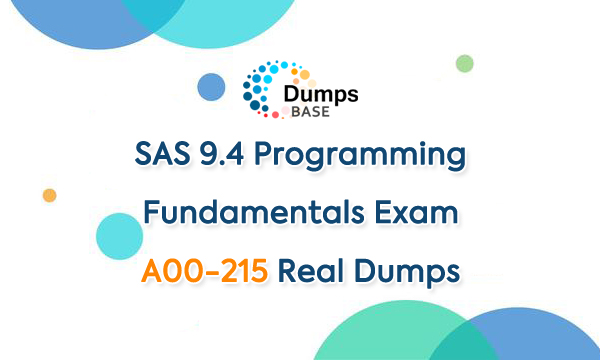SAS 9.4 Programming Fundamentals Exam A00-215 Real Dumps
Earning SAS Certified Associate: Programming Fundamentals Using SAS 9.4 certification is a great way to improve your IT career. It is required to answer A00-215 SAS 9.4 Programming Fundamentals Exam to complete your SAS Certified Associate certification. To make sure you can get the most valid and useful study materials, we have released SAS 9.4 Programming Fundamentals Exam A00-215 Real Dumps, which are based on the SAS Certified Associate: Programming Fundamentals Using SAS 9.4 exam details and knowledge points, to ensure that you can take and pass your SAS Certification Associate A00-215 exam.

SAS Certified Associate: Programming Fundamentals Using SAS 9.4 (A00-215)
SAS Certified Associate: Programming Fundamentals Using SAS 9.4 certification provides an opportunity to test the knowledge gained in your SAS training classes, and demonstrate that you understand the fundamentals of SAS programming, which is a great place to start your SAS journey. Successful candidates who have completed the SAS Certified Associate: Programming Fundamentals Using SAS 9.4 certification learned the following SAS 9.4 programming skills:
● Explore and access SAS data sets.
● Import and export non-SAS file formats.
● Control data execution with loops and conditional statements.
● Manipulate data with formulas and assignment statements.
● Create basic detail and summary reports using Base SAS procedures.
● Sort and format SAS data using Base SAS procedures.
SAS Certified Associate: Programming Fundamentals Using SAS 9.4 requires candidates to pass A00-215 exam. Real A00-215 SAS 9.4 Programming Fundamentals Exam contains 60-65 multiple choice and short-answer questions, candidates must achieve a score of 68% to pass. It should be registered at Pearson VUE.
Checking A00-215 Free Dumps Before Buying Is Nesscery
It must be clear that DumpsBase A00-215 dumps questions are based on the real A00-215 exam contents:
● Fundamental SAS Concepts
● Explore SAS Data Sets
● Using the DATA Step to Access SAS Data Sets
● Using the DATA Step to Manipulate Data
● Generate Reports Using PROC Steps
● Use Utility Procedures
● Import and Export non-SAS files
It is really great to share that DumpsBase A00-215 dumps are real for preparation. If still not trust, checking A00-215 free dumps is nesscery:
Which statement is true regarding variable names?
A. Variable names are case sensitive.
B. Variable names are from 1 to 32 characters in length.
C. Variable names are optional when you create a data set
D. Variable names can start with a number or an underscore
Answer: B
Which PROC SORT option allows you to create an output data set of the sorted data?
A. Data=
B. SORTOUT=
C. OUTPUT=
D. OUT=
Answer: A
Which statements read the input data set SASHELP. SHOES and create the output data set WORK. TOTAL?
A. data sashalp.shoes; out work.total;
B. data sashelp.shoes; output work.total;
C. data work.total; set sashelp.shoes;
D. data out=work.total; input sasholp.shoes
Answer: A
Which statement is true regarding a variable?
A. A character variable can contain alphabetic characters, numeric digits, and other special characters.
B. A numeric value must be specified in single or double quotes.
C. A character value cannot exceed 200 bytes.
D. A numeric variable can contain digits, decimal point, minus sign, currency symbol, and E for scientific notation.
Answer: C
How does SAS display missing values?
A. a period for missing numeric and a blank for missing character
B. an N for missing numeric and C for missing character
C. a blank for Doth numeric and character missing
D. a blank for missing numeric and a $ for missing character
Answer: A
Which step temporarily assign a format to the sales variable?
A. Proc format; Formatsales comma12.; Run;
B. Data sasuer. Shoes Set sashelp,sheoes; Format sales comma12.;
C. Proc contents data=sashelp.shoes; Format Sales comma12.; Run;
D. Proc print data= sashelp. Shoes Format sales comma12.; Run;
Answer: D
Which PROC PRINT option displays variable labels in the report?
A. SHOWLABELS
B. COLS
C. LABELS=
D. LABEL
Answer: C
